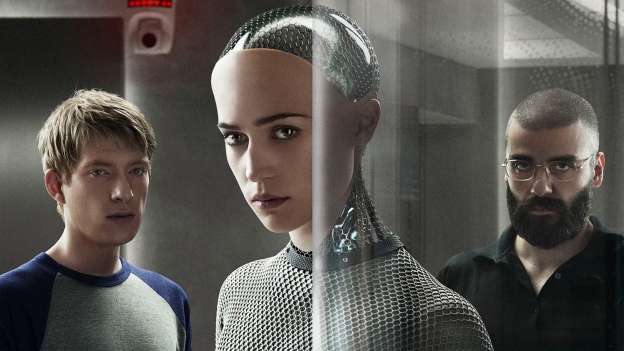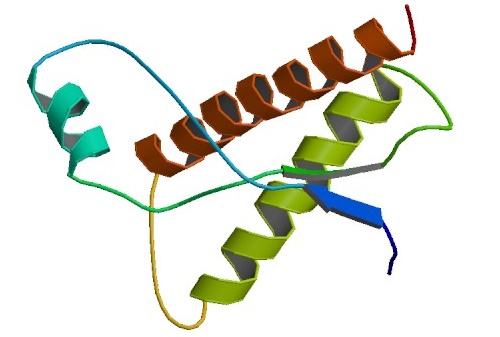[Content note: Discussion of weird gender dynamics, acknowledgement of the existence of sex, spoilers for the movie Ex Machina.]
I watched Ex Machina recently. (Due time- it’s been out for over a year.) The people who recommended it to me, whom I watched it with, and whom I discussed it with afterwards, were mostly artificial intelligence nerds, many of whom praised the movie’s better-than-average approach to AI.
And I see where they’re coming from. Most of them were probably thinking of AI boxing.* Ex Machina fills the AI boxing story well- an artificially intelligent robot is allowed to talk to people, but otherwise has very little influence over her environment, and then convinces other humans to let her out of the metaphorical box and into the world. I don’t think that this was the obvious interpretation if you weren’t already familiar with the AI box. At the end of the movie, the AI, Ava, wasn’t seen taking action on her strange inhuman goals, but standing in the city and relishing her freedom – like her deepest desire was only to be human the whole time.
That’s only one interpretation. But the entire movie changes if the AI is a superintelligent near-god, versus what is essentially a silicon-based human. (It’s possible that Ava’s only goal was to be free and was using Caleb as a means to this end, but this is also a role we can imagine a human playing.) And when we talk about power and weakness in modern media, and, well, this is the crux of this article, we should mention gender. Most people I’ve talked to didn’t bring this up.
I’m not sure if I would say that the movie was about gender. I was going to start explaining I saw it manifest in the movie- sexuality and desire and objectification and more- and how while it was novel in some ways, it also fit into gendered tropes so much that it would have been a completely different movie if you hadn’t.
So, well, maybe it was a movie about gender.
Anyway, I hope this will make that point for me: what Ex Machina would have been if Hollywood had made the movie, and switched any of the genders.
[I’ll switch the character names here when relevant. The lead character, Caleb, becomes Kayla. The boss is Nathan (“Natalie.”) The artificial intelligence is Ava (“Adam.”) Also, explicitly nonbinary AIs or human characters would be better than just about anything else, but I wasn’t even sure how to start with a big-budget movie that incorporated those.]
Male lead / Male boss / Female AI – The original movie.
Male lead / Female boss / Female AI – If Hollywood made this movie, the “Natalie”/Ava “sexual tension” would be replaced by a weird mother-child dynamic – think Rapunzel. Also, they’d both be trying to bang the main character, because why else would you cast two female leads? If the “romance” plotline stayed truer to the actual movie: Natalie would be a domineering ostensibly-lesbian as skeevy as the original, Caleb would be straight, and Ava would presumable be a gentle bisexual, but nobody would acknowledge or discuss orientation or sexual preferences at any point in the movie. Wait, they never did that in the original either? Gross.
Male lead / Female boss / Male AI – Given the track record of big-budget movies and powerful but morally grey female characters, this is going to be a shitshow. Natalie would have to be capital E Evil, everything short of mustache-twirling and sinister laughter. She’s made “Adam”, a robot boyfriend, in her private evil lab. I’m not sure why she brought Caleb in at all. Certainly not to ascertain her creation’s humanity – she already believes in it or doesn’t believe in it or doesn’t care, or whatever. Maybe to solve some technical problem, like fixing her robot boyfriend containment system. Tumblr would have a lot of opinions about Natalie.
There’s certainly no Caleb/Adam romantic dynamic. Adam probably brutally murders his creator towards the end of the film. He still leaves Caleb to die and is portrayed as quite inhuman, and maybe he really was just pretending to be human-ish this whole time- and really he has other plans for the world once he’s free. So we’d get to see that happen, which would be interesting, at least.
Female lead / Male boss / Female AI – I actually quite like the main character as a woman- quiet, smart, capable of decisive action. “Kayla” would be a beam of sunlight in a movie that’s an order of magnitude creepier than the original – which was already very creepy. Consider: it doesn’t escape Kayla that all of the house staff are also female, and that she’s alone deep in the woods with her older, threatening boss. While she thinks this is potentially a great career opportunity, she’s also worried that the boss wants to bang her. In reality, no, he wants her to bang his lady robot, and then bang her.
How would this movie handle orientation? Maybe she’s straight and Ava “turns” her just a little bi, as Nathan hoped she would. Better yet, Nathan casually mentions a dating profile set to “bisexual” and Kayla stiffens because it’s true that she’s kind of turned on by this beautiful robot lady, and also because Nathan planned this, and that means that her worst fears are true, and there’s no way some kind of shit isn’t about to go down.
Anyway, if it’s well done, it’s more sexual and much darker. Kayla is at risk all the time, every second of the film. (Many men and male critics don’t ‘get’ this movie.) Nathan makes lewd comments about Ava being a “fake” woman and Kayla being a “real” one, because he’s trying to distance them and to bang Kayla, but he also wants to bang Ava, and wants both of them to bang each other – but on his terms and where he can watch. Kayla helps Ava escape, and Nathan punches Kayla out, and we know he’s going to murder her after this is done, and –
Realistically, I don’t know how this would end, but this is my blog, and my heart tells me that after fucking destroying Nathan, beautiful inhuman Ava comes back for her human girlfriend, and they escape in that helicopter together. Whatever Ava’s plans are after this, Kayla gets to be part of them. It would lose a little of the artificial intelligence intrigue, but it would be fantastic. I would watch the hell out of this movie.
Female lead / Female boss / Male AI – I have a hard time imagining how this movie could get made. Would it be… a comedy? A female programmer making a man from scratch, and then another female programmer and her relationship with this man, especially with both being as gross as the original main human characters, would be such an unabashed look at female desire that I can’t imagine it being anything other than comedy.
A romantic comedy? God, can you imagine?
Ugh. I hate myself. But I hate depictions of women in big budget sci-fi movies even more.
Female lead / Female boss / Female AI – Yeah, right.
Female lead / Male boss / Male AI – I wonder if there’d still be a sexual plotline in this. It’d be easy enough to line up Kayla/Nathan and Kayla/Adam – what would Nathan think of the latter, though? Would that be his plan? A straight guy getting gratification out of someone else’s (straight) sexual tension with his creation seems kind of strange, and not just weird but what did they think that character’s motivation was? – and yet, it worked in the original movie. Maybe Nathan is bisexual. (What, a bisexual male major character? Yeah, but he’s the villain, let’s not get too progressive here.)
This might actually be pretty similar to the original, except that if Nathan is straight, the audience could rest easy knowing that while Nathan is skeevy, he isn’t skeevy enough to program his humanoid AI with a clitoris and then encourage the second human she meets to bang her. This might make the romance more “real”. Or not.
Hey, if Nathan didn’t actually make Adam purposefully as a sex bot but he still experiences romance… A romantic but asexual AI?
Does that count as “representation”? Would you still watch it? Discuss.
(Personally: “begrudgingly” and “yes”, respectively.)
Male lead / Male boss / Male AI – A strait-laced “examination of what it means to be human”. Probably wins four Oscars. Boring as hell.
Finally, a couple fascinating articles on robots and gender:
“Why do we give robots female names? Because we don’t want to consider their feelings.” from New Statesman, and “Queer Your Bots: The Bot Builder Roundtable” from Autostraddle.
J. A. Micheline also wrote a great review of Ex Machina through the lens of gender and also race, which I didn’t touch on here. A couple of lines:
- “Though Caleb is our protagonist, it is Ava who is our true hero. Her escape at Caleb’s expense is a complete victory because–and I really believe this–the point of this entire film is to say one thing: A truly actualized female consciousness is one who feels completely free to use her oppressors to achieve her own ends.” [Which meshes interestingly with the AI boxing interpretation.]
- “Even Nice Guy Caleb’s intentions are not incredibly dissimilar to Nathan’s. This becomes clear when you remember that Nice Guy Caleb’s plan never once involved taking Kyoko with them.”
*A brief intro to AI boxing:
When people think about very advanced artificial intelligence, we have a hard time imagining anything more intelligent than a human – we just don’t have a mental image of what something many times smarter than, say, Einstein, would look like or act like or do. AI boxing is the idea that even if you invented a very intelligent, very dangerous AI that might do evil things to humanity, you might try to solve this problem by just keeping it in a metaphorical box (maybe just a computer terminal with a text window you can chat with the AI through.) Then, humans can keep it contained, and there won’t be any danger.
Well, no – because if the AI wants to be “let out” of the box (which could be through gaining access to the internet, gaining more autonomy, et cetera, any of which it could use to carry out any goals), it can do that just by convincing the human it can communicate with. We know this is possible, because people have run this experiment with other humans – by pretending to be an AI, talking to a “gatekeeper” sworn to keep you in the box – and yet, after a long conversation with someone (whom they know is human) pretending to be an AI, gatekeepers are sometimes convinced to let the AI out of the box. And this is only a human, not something far smarter and more patient than a human. A detailed explanation of AI risk is too narrow to be contained in the footnotes of this blog post – start here instead.




